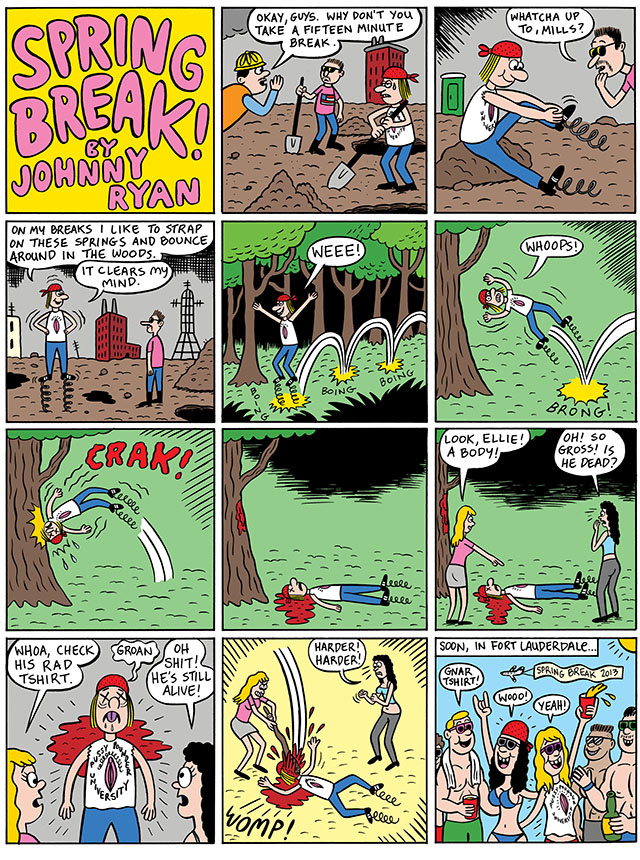The index to the Indie Comics vs. Context roundtable is here.
____________
I talked about this comic a bit in comments over here. It’s still on my mind several weeks later. It’s one of the favorite things I’ve seen by Johnny Ryan, I think. I love its rhythm; it has a merciless dream logic that has more to do with Kafka or David Lynch than with standard gag cartooning. (Which is probably why the commenters at Vice seem so thoroughly alienated.
Beyond that, and intertwined with it, I really like the way that gender in the comic is both omnipresent and divorced from individual bodies. The main character, Mills, wears a t-shirt with a picture of a vagina on it that says “Pussy Pounder University.” Mills appears to have a working class masculine job digging holes, so you could see the shirt as a kind of frat-brother marker of hyper-masculinity.
But the strip mostly works against that reading. When he has a break from his job, Mills doesn’t do manly things like drinking beer or checking sports stats; instead he straps springs onto his feet and goes bouncing off into the woods. The bizarre panel where we see him first standing with the springs has him, unnaturally tall in the foreground, juxtaposed with a television tower in the background. It semss like a parody of masculine imagery, turning Mills into a failed phallus. That’s more or less confirmed when he goes bouncing off into the woods shouting “wee!” and then immediately stumbles and bashes his head against a tree trunk.
Up to this point, we haven’t really gotten a clear view of the shirt. When we finally see that he’s wearing a vagina, he’s flat on the ground bleeding from the head. In fact, in the image, his head looks like the vagina on his shirt; the line of his mouth mirrors the curve of the text, and his tongue looks like the lips in the image. The liquid coming out of his mouth becomes a double entendre for sexual lubrication; the blood reads as menstrual blood. He isn’t a dude-bro who owns the pussy as a sign of hyper-masculinity. Rather, he is his shirt, a feminized victim of violence.
If a man can become a symbolic vagina, then it makes sense that a woman can become a symbolic phallus — which is what happens in the next panel. Just as Mills initially seems to fit into a standard male stereotype, so the women who find him seem default valley girls, grossed out by blood, shallowly distracted by fashion (“Whoa, check his rad shirt!”) But then they pick up a giant stick/penis and start thrusting it into Mills’ head/vagina while screaming “Harder! Harder!” The rape imagery is not especially subtle — and what they get from that rape is the shirt with its symbolic vagina, turning them into the bros partying with the other guys at spring break.
The structure of the strip — build-up, violence, pause, escalation of violence — imitates, or references, rape-revenge narratives. But the dislocation of gender dislocates the violence as well. Unjust violence doesn’t lead to just violence; the victim does not become the victimizer. Instead, the victim just gets attacked again, because when you’re weak people take your stuff. Femininity is still, as in rape-revenge, used as a narrative trigger for violence, but that trigger is presented self-consciously as symbolic. “Woman” is an arbitrarily assigned position; a marker that has more to do with narrative convention than it does with actual bodies or identities. The vagina on the shirt is, for that matter, no more or less a drawing than Mills or the girls who find him. Why do we see Mills as male initially, anyway? “Mills” isn’t a strongly gendered name; he’s got mid-length blonde hair. No one refers to him as “he” in the first part of the strip; we just know he’s a guy because he’s digging that hole, which is a guy thing, and the people around him have facial hair. In a narrative, gender is a convention — but a convention that can kill.
I doubt Ryan would exactly agree that this was the context of his strip. He’d probably say that he wasn’t thinking about it that hard, or that he was just following his ideas wherever they took him. Still, I don’t think that makes me wrong. The central idea here — that weird vagina shirt — seems in keeping with a lot of Ryan’s comics, where gendered body parts float free of the bodies they’re supposed to be attached to, and narratives of gendered violence are scrambled with a malevolent clumsiness. It’s body horror as failed punchline, bouncing carelessly along till you bash your brains and/or gender out in the forest. Even then, though, meaning is still drawn on you; arbitrary and inescapable, like Fort Lauderdale.

